This American created football — here's the fascinating story
Walter Camp, a native of Connecticut, invented this hugely popular game.
Baseball may be America’s pastime, but football is its passion.
One man, Walter Camp, did more than any other American to shape the nation’s love affair with the sport today.
"What Washington was to his country, Camp was to American football, the friend, the founder and the father," John Heisman, the late longtime coach and namesake of the iconic college football trophy, once said.
Most notably, Camp’s vision turned a primitive — and often deadly — college activity into a uniquely American sporting spectacle with passionate devotees at the high school, college and professional levels.
Thirty-seven men were killed on college football fields in the 1904 and 1905 seasons. The national outcry over the brutality forged a partnership between President Theodore Roosevelt and Walter Camp that made football less brutal and more popular than ever.
Camp (1859-1925) was a Connecticut native and star player at Yale from 1876 to 1881 during American football’s infancy.
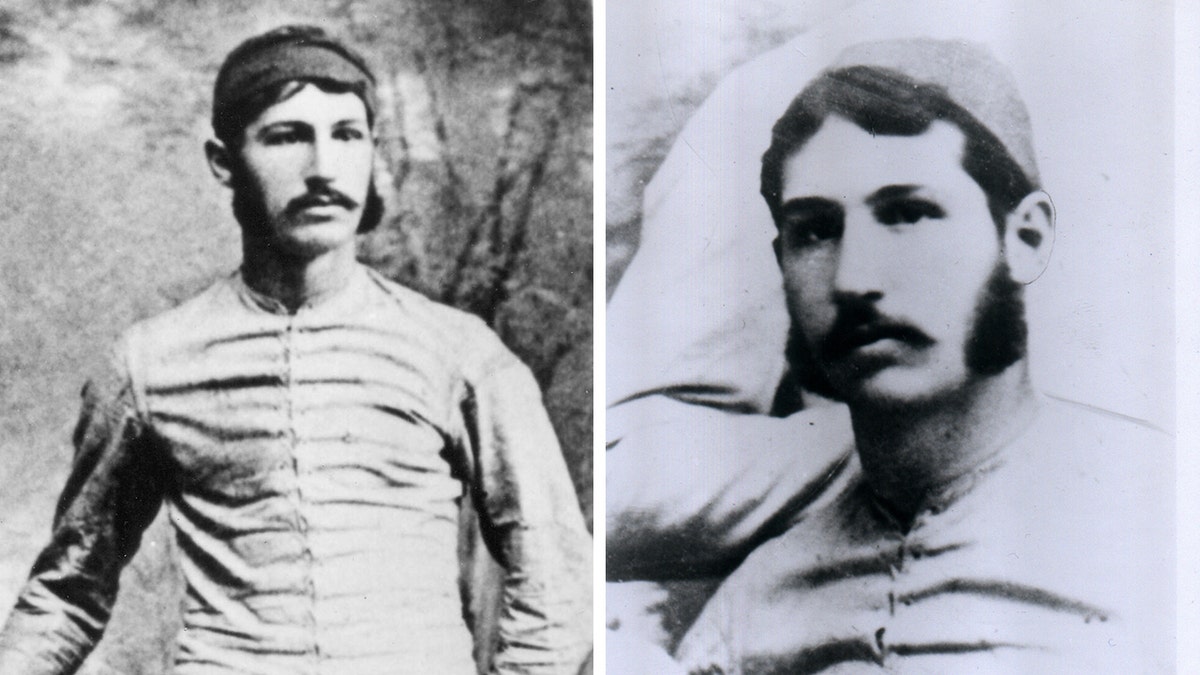
Walter Camp starred for Yale University from 1876 to 1881 in the early days of American football. He was later dubbed the "father of football" for his contributions to the game as a coach, administrator and author. (Courtesy Yale Athletics)
He became the university’s football coach from 1888 to 1892 while carving out a legacy in just a few short years — a legacy that shapes the game today.
Camp’s 1888 Yale team went 13-0 and outscored its opponents 694-0. By many accounts, it was the single most dominant team in more than 150 years of college football history.
"What Washington was to his country, Camp was to American football."
He later served as administrator, rule maker, author and pigskin proselytizer, writing dozens of books and hundreds of articles about football while serving on national rules committees for over four decades in the formative years of the sport.
"Camp revolutionized football," Rich Marazzi, author of "A Bowl Full of Memories: 100 Years of Football at The Yale Bowl," told Fox News Digital.
"He gave us the sport we know today."

Yale University's 1888 football team, coached by Walter Camp, went 13-0 and outscored it opposition 694-0. (ullstein bild via Getty Images)
Football was never "invented" as basketball or volleyball were. Instead, it evolved out of soccer and rugby. And in the early years of that evolution, the rules of "Foot Ball" — as it was written at the time — were often inconsistent.
Camp introduced standard parameters of the game that all fans recognize today. A line of scrimmage, the system of four downs and the rules of 11 men on the field per side were all pioneered by Camp.
He gave the sport its first All-America teams — a compilation of the best college football around the nation. The All-America team is still published by the Walter Camp Football Foundation each year.
Camp also gave offenses the standardized formation of seven players on the line of scrimmage and four in the backfield that is still used today.
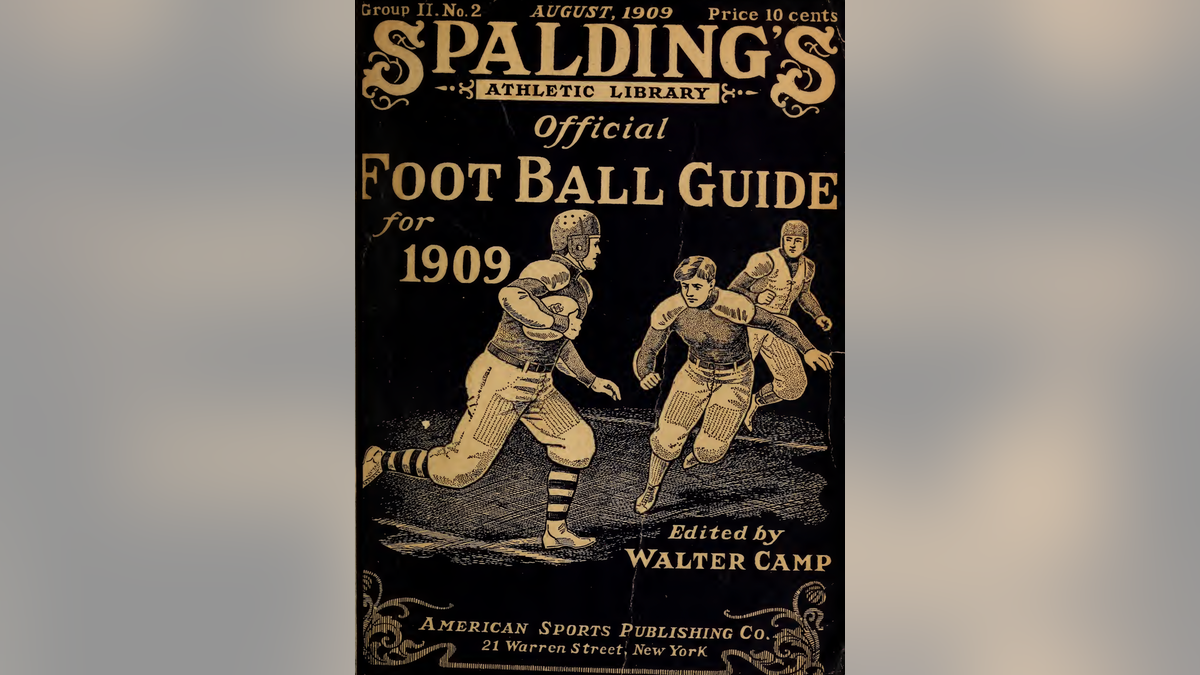
Walter Camp edited the Spalding's Foot Ball Guide, for many years the authority on the sport. He was called "the father of foot ball" in the 1909 edition. (Walter Camp Football Foundation)
"In 1878, while still in his teens, Camp attended a rules meeting at Springfield (Mass.), and from then until his death in 1925 he was a member of every rules committee, ‘the father of American football,’" Richard Goldstein wrote in his 1996 book, "Ivy League Autumns."
COLLEGE FOOTBALL PLAYOFF TO EXPAND TO 12 TEAMS: REPORT
"Soon everybody would be playing the same regulations, thanks to the leadership of Camp."
So Camp was the ultimate authority on the game, the true "father of football."
When a small college in the Midwest was looking to build its football program, it turned to Camp.
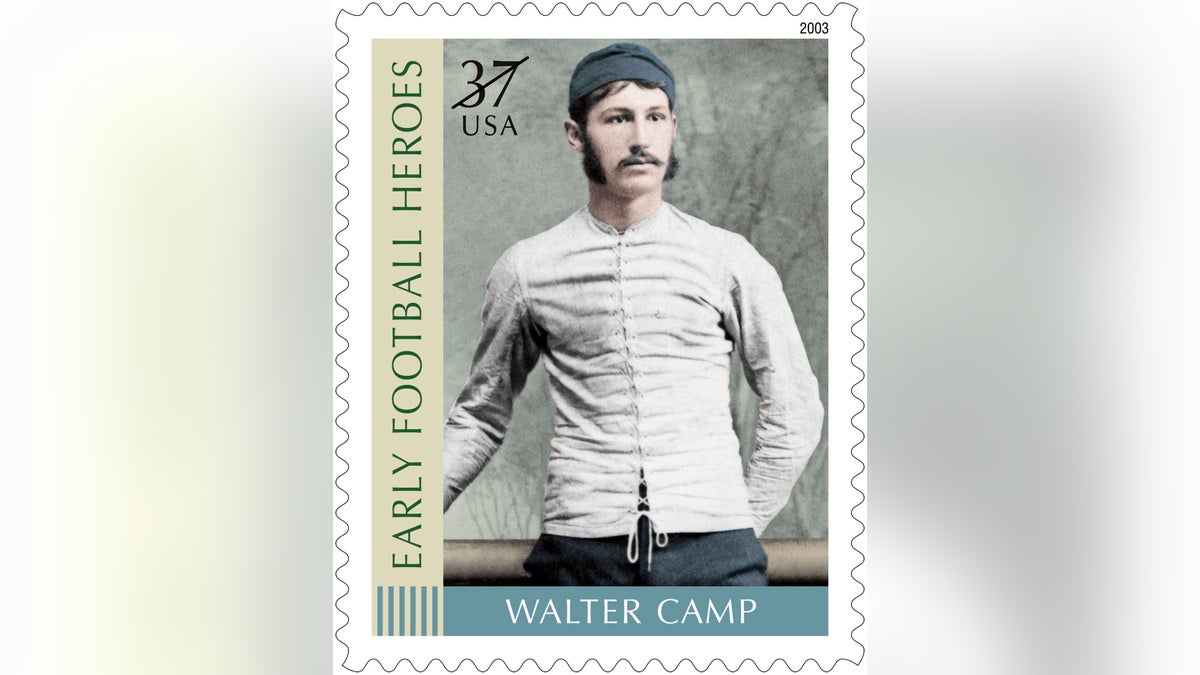
The U.S. Postal Service issued a Walter Camp stamp in 2003 to pay tribute to his unparalleled contributions to American football. (United States Postal Service)
"Dear sir, I want to ask a favor of you. Will you kindly furnish me with some points on the best way to develop a good football team?" Notre Dame football coach James Kivlan wrote to Walter Camp in 1892.
Sports come of age in post-Civil War America
Walter Chauncey Camp was born on April 7, 1859, in New Britain, Conn., to Leverett and Ellen Sophia (Cornwell) Camp.
His family traced its history in America to some of the earliest European settlers, including Nicholas Camp of Essex, England, who landed in the new Massachusetts Bay Colony in 1630.
Camp came of age in a post-Civil War America that was bursting with opportunities, including new means of recreation.

Walter Camp was a star player, then coach, at Yale. He then became a leading authority in the early days of the sport and shaped it into the game that millions of fans know today. (Courtesy Yale Athletics)
"Leisure activities were becoming an important center in the life of people at the time," past Walter Camp Football Foundation President Tom Lally told Fox News Digital.
The Cincinnati Red Stockings fielded the first professional baseball team in May 1869, just four years after the war.
A few months later, in the autumn of 1869, Rutgers battled Princeton in the first college football game. Other elite eastern schools, Yale and Harvard most notably, soon fielded football teams, too.
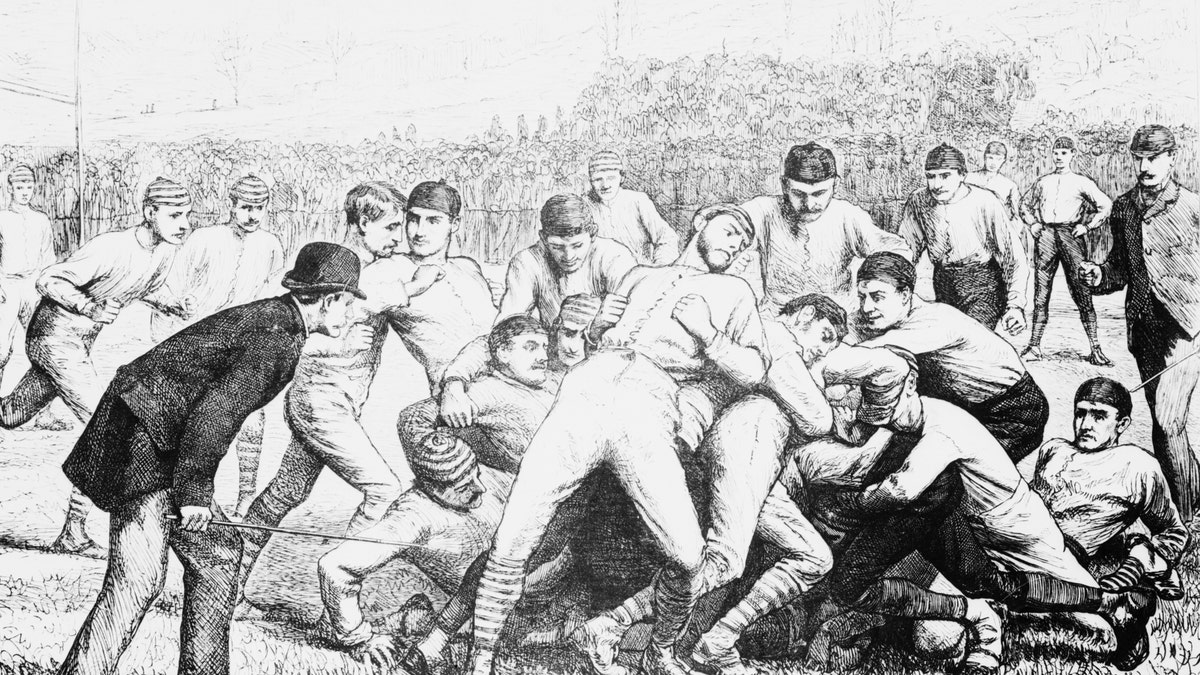
A football game between Yale and Princeton in 1879. Walter Camp was captain of the 1879 Yale football team. Drawing by A.B. Frost. (Getty Images)
The sport evolved out of a mash-up of soccer and rugby — and rules were often inconsistent.
"When Yale played at Harvard, Harvard allowed 11 men per side," much like soccer, Lally told Fox News Digital.
Eighteen college football players were killed in 1904, followed by 19 more in 1905.
"When Harvard played at Yale, Yale would play with 15" — that's the number of players used in rugby.
Football was also played in a nation apparently desensitized to bloodshed during the horrific human carnage of a war that had ended only four years earlier.

A practice game is shown in Yale Magazine; illustrations by Frederic Remington. The artist who grew to fame portraying the American west played football at Yale with Walter Camp. (©CORBIS/Corbis via Getty Images)
"At one point in the game, you could literally punch the player with the ball," said Lally.
Blood colored the sport.
The first few decades of football were so violent that players were being killed on the field, inspiring ever louder calls to ban the brutal sport.
Famed American artist Frederic Remington played for Yale alongside Camp in 1879 and 1880, "once dipping his jersey in blood in a New Haven slaughterhouse before a Harvard game to appear ‘more businesslike,’" Goldstein wrote in "Ivy League Autumns."
Camp helps Roosevelt save the game
If Camp was the George Washington of football, as Heisman called him, then his "Crossing the Delaware" moment to save the American cause came in 1905 at the behest of President Teddy Roosevelt.
The first few decades of football were so violent that players were being killed on the field, inspiring ever louder calls to ban the brutal sport.
The Harvard-Yale game of 1894, played in Springfield, was so violent it was dubbed the "Bloodbath at Hampden Park" and reached the international press.
"It turned into an awful butchery," Goldstein wrote in "Ivy League Autumns," quoting a Munich newspaper.
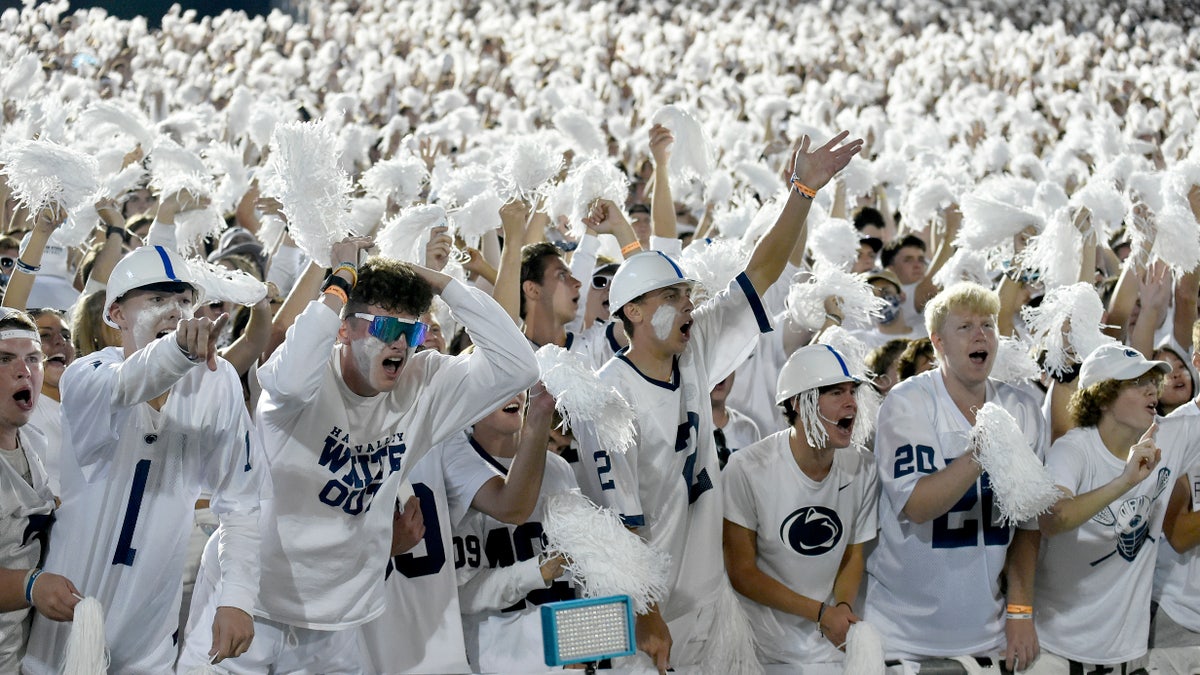
Walter Camp's legacy lives on in the size, scope and success of college and professional football in America. Beaver Stadium, home of Penn State University football, seats nearly 107,000 people, making it one of the largest arenas in global sports. Shown in this image: Auburn Tigers at Penn State Nittany Lions, Sept. 18, 2021. (Randy Litzinger/Icon Sportswire via Getty Images)
"Of 22 participants, seven were so severely injured that they had to be carried from the field in dying condition. One player had his back broken, another lost an eye and a third lost a leg. Both teams appeared upon the field with a crowd of ambulances, surgeons and nurses."
"The public outcry following the game was swift and far-reaching," the Yale Alumni Magazine wrote in 2004.
"The sport was now under fire from every corner of society. Members of the clergy and law enforcement officials issued denunciations."
The breaking point for the American public came when 18 players were killed on the field during the 1904 college football season alone, according to the Chicago Tribune; almost incredibly, that was followed by 19 more football deaths in 1905.
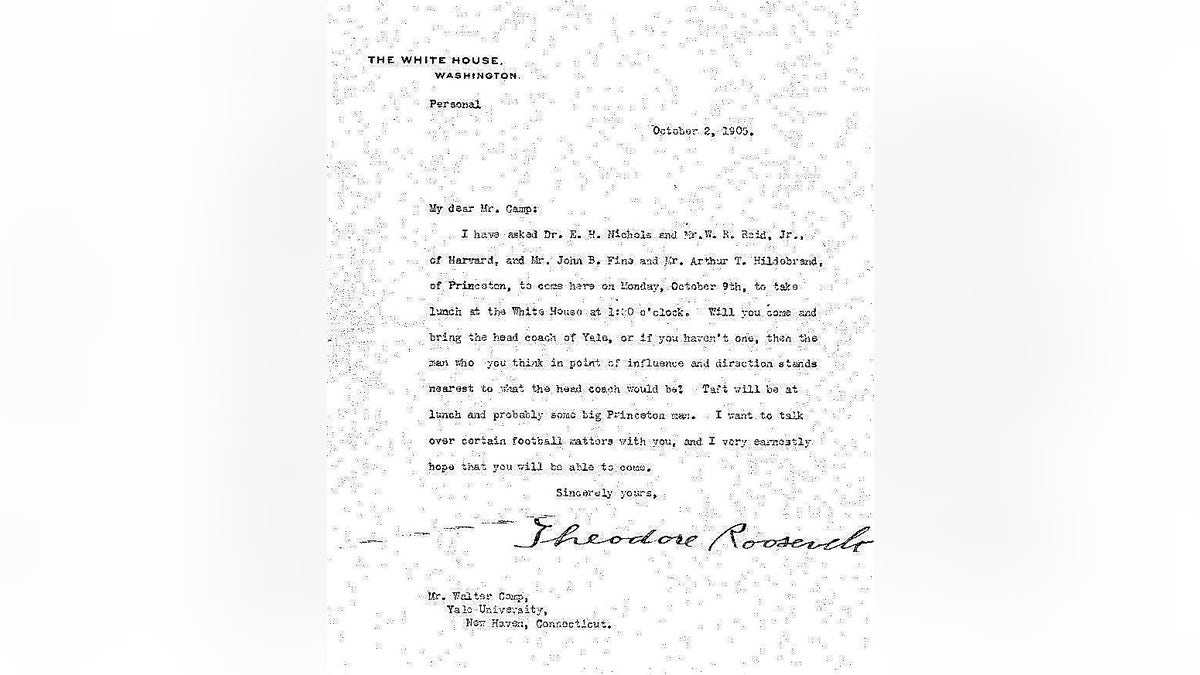
Football grew so violent and even deadly in the early 20th century that calls came to ban the sport. President Theodore Roosevelt, a football fan, enlisted the aid of Walter Camp and other leaders of the game to save football. (Walter Camp Football Foundation)
President Theodore Roosevelt, who praised the sport for helping forge a culture of American vitality and masculinity, could no longer fend off the public.
"I believe in rough games and in rough, manly sports," the president said in 1903.
"I do not feel any particular sympathy for the person who gets battered about a good deal so long as it is not fatal."
The meeting led to the creation of an oversight group to manage the rules and safety of football.
He was forced to throw a Hail Mary to Camp and other leading figures of the game to save the sport after so many on-field fatalities.
"My dear Mr. Camp," the president wrote, in a note he signed on White House letterhead. "I want to talk over certain football matters with you, and I very earnestly hope that you will be able to come."
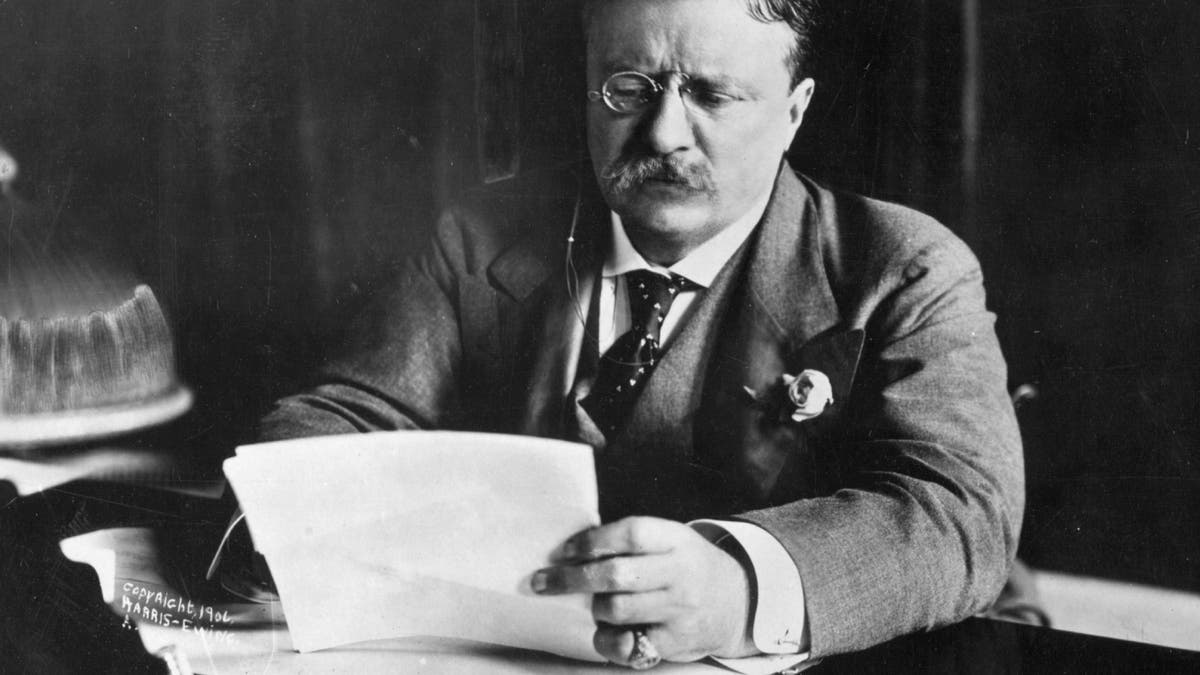
Theodore Roosevelt, the 26th president of the United States (1901-09), is shown working at his desk circa 1905. (Hulton Archive/Getty Images)
The meeting inspired dramatic changes in football.
Most notably, the meeting led to the creation of an oversight group to manage the rules and safety of football. It was called the Intercollegiate Athletic Association of the United States, the precursor of the NCAA.
The meeting of Camp and other football leaders yielded a dramatic on-field change, too: rules were introduced, and a new innovation was encouraged.
It was called the forward pass. It opened up the game and added speed and grace to a game that had been made of pure brute force.
The rule changes made the game safer — and ultimately more popular.
Creating a path to unprecedented success
Walter Camp died in his sleep in New York City on March 14, 1925. He was 65 years old. `
He is buried at Grove Street Cemetery in New Haven, Conn., the home of Yale University, along with his wife Alice Sumner.
MEET THE AMERICAN WHO FOUNDED THE GRAND OLE OPRY: ‘REMARKABLE VISIONARY GEORGE D. HAY’
Yale erected a monument to Camp’s contribution to the school and to the sport, the Walter Camp Memorial Gateway, at the Yale Bowl in 1928.
The U.S. Postal Service issued a Walter Camp stamp in 2003, honoring his role in creating the great American game.
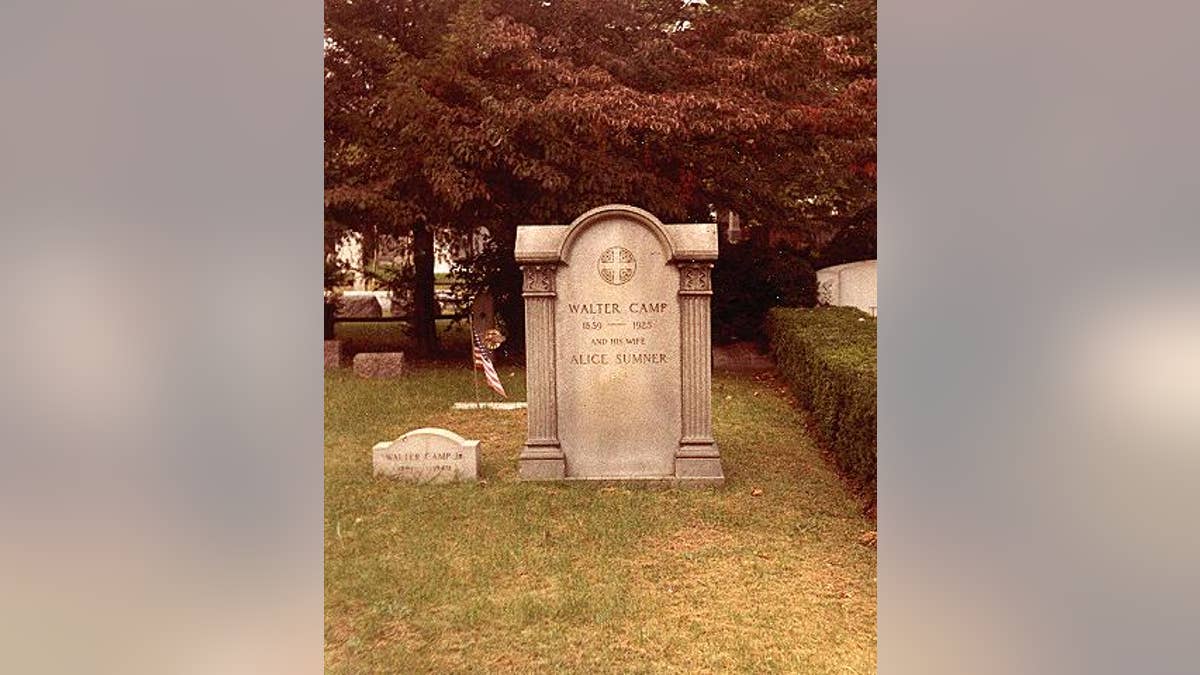
Walter Camp died March 14, 1925, in New York City. He was 65 years old. He's buried in Grove Street Cemetery with his wife Allison in New Haven, Conn. (Courtesy Sam Gindy)
His legacy is best represented in the unprecedented success of the sport he helped to shape so profoundly: American football.
CLICK HERE TO SIGN UP FOR OUR LIFESTYLE NEWSLETTER
Eight of the 10 largest sports arenas in the world are American college football stadiums, each of which seats over 100,000 people, according to Fox Sports Australia.
The short list of the world's largest sports arenas spans the college football landscape: Michigan Stadium (University of Michigan), Kyle Field (Texas A&M) and Neyland Stadium (University of Tennessee), to name just three.

Tennessee Volunteers cheerleaders entertain fans during the first half of a game against the Utah State Aggies at Neyland Stadium in 2014. (Jim Brown/USA Today Sports)
The Yale Bowl was the largest stadium in the nation, seating 71,000 people, when it opened in 1914, with Camp serving in the university administration.
The National Football League, born in 1920 in the wake of the popularity and cultural dominance of college football, is today the most profitable professional sports league in the world.
CLICK HERE TO GET THE FOX NEWS APP
In a deal announced in March 2021, the NFL was set to nearly double its media revenue to more than $10 billion a season with new rights agreements, including a deal with Amazon Prime Video that gives the streaming service exclusive rights to "Thursday Night Football" beginning in 2022, the AP reported last year.
Camp's "fame rests upon the fact that he, above all others, was responsible for conceiving and bringing into being the game of football, which typifies the American competitive spirit in its premium upon imagination, speed, strategy and daring, as well as upon sheer physical ability and durability," proclaims the Walter Camp Football Foundation today.
To read more stories in this unique "Meet the American Who…" series from Fox News Digital, click here.






















